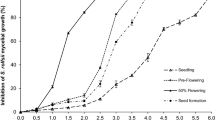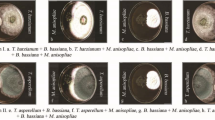Abstract
Collar rot of betelvine (Piper betle L.) is an important disease in India, caused by Athelia rolfsii (Curzi) C.C. Tu and Kimbr. (syn. Sclerotium rolfsii Sacc.) Management of this soil borne pathogen is highly challenging in the shade house (boroj) condition, where betelvine is grown as a perennial climber. As betel leaves are consumed raw, application of chemical fungicides is highly restricted to safeguard human health. The present study compared various integrated disease management packages by suitable combination of biofumigation, biocontrol and soil solarization strategies and evaluated the best package at farmers’ field condition. The treatment combination of “biofumigation with 0.7 kg m−2 green biomass of Indian mustard cv. Pusa Mahak” + “curing of soil by resting for 5 months in the form of heap followed by soil solarization for 30 days” + “biocontrol with 10 g m−2 Trichoderma sp. T-Nam colonized whole rice grain” was found to be the most economical and effective disease management option with highest leaf yield in the experimental plot. This package resulted in 76.82% reduction in collar rot incidence, 29.94% increase in leaf yield and 41.45% increase in net income during March-June crop cycle, in farmers’ field condition, when compared to the Farmers’ Practice (soil drench with 4 L m−2 0.25% Blitox 50 W). Trichoderma was found to be highly tolerant to the biofumigation volatiles, which maintained a good soil population (32.78 × 103 CFU g−1 soil) in the farmers’ plots adopting integrated disease management. Biofumigation with Indian mustard and biocontrol with local isolate of Trichoderma offered an economical management of the collar rot disease in betelvine, without compromising the crop yield and the population of Trichoderma spp. in soil.

Similar content being viewed by others
Availability of data and material
The data and material used during the current study are available from the corresponding author on reasonable request.
Abbreviations
- BCR:
-
Benefit-cost ratio
- CFU:
-
Colony forming unit
- DI:
-
Disease incidence
- FP:
-
Farmer’s Practice
- IDM:
-
Integrated Disease Management
- ₹:
-
Indian Rupee
- cv.:
-
Cultivar
- syn.:
-
Synonym
References
Anonymous (2015) Annual Report of Directorate of Medicinal and Aromatic Plants Research (DMAPR) - 2014–15, Boriavi, Anand, Gujarat, India, pp 73. https://dmapr.icar.gov.in//Publications/AnnualReport/E%20Annual%20Report%20%202014–15.pdf
Anonymous (2020) Major uses of Pesticides (Registered under Insecticides Act, 1968): Fungicides (upto 31/01/2020). Department of Agriculture Cooperation, Ministry of Agriculture and Farmers Welfare, Directorate of Plant Protection, Quarantine & Storage, Central Insecticide Board & Registration Committee, N.H.-IV, Faridabad-121 001 (Haryana), pp 7. http://ppqs.gov.in/divisions/cib-rc/major-uses-of-pesticides
Baker LW, Fitzell DL, Seiber JN, Parker TR, Shibamoto T, Poore MW, Longley KE, Tomlin RP, Propper R, Duncan DW (1996) Ambient air concentrations of pesticides in California. Environ Sci Technol 30:1365–1368. https://doi.org/10.1021/es950608l
Baysal-Gurel F, Liyanapathiranage P, Addesso KM (2019) Effect of Brassica crop-based biofumigation on soilborne disease suppression in woody ornamentals. Can J Plant Pathol. https://doi.org/10.1080/07060661.2019.1625444
Bloemofield B, Alexander M (1967) Melanins and resistance of fungi to lysis. J Bacteriol 93:1276. https://doi.org/10.1128/jb.93.4.1276-1280.1967
Charron CS, Sams CE (1999) Inhibition of Pythium ultimum and Rhizoctonia solani by shredded leaves of Brassica species. J Amer Soc Hort Sci 124: 462–467. https://doi.org/10.21273/JASHS.124.5.462
Dasgupta B, Dutta P, Das S (2011) Biological control of foot rot of betelvine (Piper betleL.) caused by Phytophthora parasitica Dastur. J Pl Prot Sci 3(1): 15–19. http://researcherslinks.com/current-issues/Biological/23/5/558
Datta P, Dasgupta B, Das S (2011) Efficacy of Trichoderma spp. against Sclerotium rolfsii. J Mycopathol Res 49(1): 31–38. https://www.cabdirect.org/cabdirect/abstract/20133277185
Deshpande AL, Tiwari RKS (1991) Effect of solarisation on sclerotia of Sclerotium rolfsii causing collar rot in betelvine. Indian Phytopathol 44(3): 353–355. https://www.researchgate.net/publication/333166230_Effect_of_solarisation_on_sclerotia_of_Sclerotium_rolfsii_causing_collar_rot_in_betelvine
Elad Y, Chet I (1983) Improved selective media for isolation of Trichoderma spp. or Fusarium spp. Phytoparasitica 11(1): 55–58. https://doi.org/10.1007/BF02980712
Elad Y, Mishagi IJ (1985) Biochemical aspects of plant-microbe and microbe-microbe interactions in soil. In: Copper - Driver GA, Swain T (eds), Chemically mediated interactions between plants and other organisms, Recent Adv Phytochem, New York: Plenum Press, pp 21. https://doi.org/10.1007/978-1-4757-9658-2_2
Galletti S, Sala E, Leoni O, Burzi PL, Cerato C (2008) Trichoderma spp. tolerance to Brassica carinata seed meal for a combined use in biofumigation. Biol Control 45:319–327. https://doi.org/10.1016/j.biocontrol.2008.01.014
Garain PK, Mondal B, Dutta S (2021) Effect of biofumigation by Indian mustard (Brassica juncea L.) on Sclerotium rolfsii Sacc., causing collar rot in betelvine (Piper betle L.). Indian Phytopathol 74:1015–1025. https://doi.org/10.1007/s42360-021-00407-2
Garain PK, Mondal B, Maji A, Dutta S (2020) Survey of major diseases in Mitha Pata variety of Betelvine (Piper betle L.) under Coastal Saline Zone of West Bengal, India. Int J Curr Microbiol App Sci 9(3):2490–2498. https://doi.org/10.20546/ijcmas.2020.903.285
Gullino ML, Camponogara A, Gasparrini G, Rizzo V, Clini C, Garibaldi A (2003) Replacing Methyl Bromide for Soil Disinfestation: The Italian Experience and Implications for Other Countries. Plant Dis 87(9):1012–1021. https://doi.org/10.1094/PDIS.2003.87.9.1012
Harvey SG, Hannahan HN, Sams CE (2002) Indian Mustard and Allyl Isothiocyanate inhibit Sclerotium rolfsii. J Amer Soc Hort Sci 127(1): 27–31. http://dx.doi.org/https://doi.org/10.21273/JASHS.127.1.27
Kirkegaard J, Sarwar M (1998) Biofumigation potential of brassicas. Plant Soil 201:71–89. https://doi.org/10.1023/A:1004364713152
Lifshitz R, Tabachnik M, Katan J, Chet I (1983) The effect of sublethal heating on sclerotia of Sclerotium rolfsii. Can J Microbiol 29:1607–1610. https://doi.org/10.1139/m83-246
Madhavi GB, Uma Devi G (2018) Effect of combined application of biofumigant, Trichoderma harzianum and Pseudomonas fluorescens on Rhizoctonia solani f. sp. sasakii. Indian Phytopathol 71:257–263. https://doi.org/10.1007/s42360-018-0039-6
Maiti S, Sen C (1982) Incidence of major diseases of betel vine in relation to weather. Indian Phytopathol 35(1): 14–17. https://www.cabi.org/isc/abstract/19851309785
Matthiessen JN, Kirkegaard JA (2006) Biofumigation and Enhanced Biodegradation: Opportunity and Challenge in Soilborne Pest and Disease Management. Crit Rev Plant Sci 25(3):235–265. https://doi.org/10.1080/07352680600611543
Omirou M, Rousidou C, Bekris F, Papadopoulou KK, Menkissoglou-Spiroudi U, EhaliotisC KDG (2010) The Impact of Biofumigation and Chemical Fumigation Methods on the Structure and Function of the Soil Microbial Community. Microb Ecol 61:201–213. https://doi.org/10.1007/s00248-010-9740-4
Punja ZK, Jenkins SF (1984) Influence of temperature, moisture, modified gaseous atmosphere and depth in soil of eruptive sclerotial germination of Sclerotium rolfsii. Phytopathology 74: 749–754. https://www.apsnet.org/publications/phytopathology/backissues/Documents/1984Articles/Phyto74n06_749.PDF
Relevante CA, Cumagun CJR (2013) Control of Fusarium wilt in bittergourd and bottlegourd by biofumigation using mustard var. Monteverde Arch Phytopathol Pflanzenschutz 46(6):747–753. https://doi.org/10.1080/03235408.2012.751285
Sarwar M, Kirkegaard JA, Wong PTW, Desmarchelier JM (1998) Biofumigation potential of Brassicas: III. In vitro toxicity of isothiocyanates to soilborne fungal pathogens. Plant Soil 201:103–112. https://doi.org/10.1023/A:1004381129991
Sengupta DK, Dasgupta B, Datta P (2011) Management of foot rot of betel vine (Piper betle L.) caused by Phytophthora parasitica Dastur. J Crop and Weed 7(2):179–183. https://www.cropandweed.com/vol7issue2/pdf/39.pdf
Singh A, Singh HB (2005) Trichoderma harzianum suppresses collar rot disease of Betelvine caused by Sclerotium rolfsii. Paper presented in Second Global Conference of Indian Society of Mycology and Plant Pathology at MPUAT, Udaipur, 25–29 November 2005, pp194.
Stapleton JJ, Duncan RA (1998) Soil disinfestations with Cruciferous amendments and subleathal heating effects on Meloidogyne incognita, Sclerotium rolfsii and Pythium ultimum. Plant Pathol 47: 737–742. https://www.researchgate.net/publication/259044054_Soil_disinfestation_with_cruciferous_amendments_and_sublethal_heating_Effects_on_Meloidogyne_incognita_Sclerotium_rolfsii_and_Pythium_ultimum
Stapleton JJ, Elmore CL, DeVay JE (2000) Solarization and biofumigation help disinfest soil. Calif Agri 54(6):42–45. https://doi.org/10.3733/ca.v054n06p42
Tripathi AK (2015) Management of Sclerotial wilt disease of betelvine in Madhya Pradesh. The Bioscan 10(4): 1683–1685. https://www.semanticscholar.org/paper/MANAGEMENT-OF-SCLEROTAIL-WILT-DISEASE-OF-BETELVINE-Tripathi/691f30f4daa823abb8124f2ee6b20267c8eae076
Tripathi NN, Grover RK (1978) Comparison of fungicides for the control of Pythium butleri causing damping off of tomato in nursery beds. Indian Phytopathol 30:489–496
Van den Berg F, Ross AH, Tuinstra LG, Leistra M (1994) Measured and computed concentrations of 1, 3-dichloropropene and methyl isothiocyanate in air in a region with intensive use of soil fumigants. Water Air Soil Pollut 78:247–264. https://doi.org/10.1007/bf00483035
Vikram A, Hamzehzarghani H (2011) Integrated Management of Sclerotium rolfsii (Sacc.) in Groundnut (Arachis hypogaea L.) under pot culture condition. Pest Technology 5(1): 33–38. http://www.globalsciencebooks.info/Online/GSBOnline/images/2011/PT_5(1)/PT_5(1)33-38o.pdf
Yella Goud T, Uma Devi G, Narayan Reddy P, Siva Sankar A (2017) Effect of Volatile Toxins of Brassica Residues on Groundnut Stem and Pod Rot Disease caused by S. rolfsii. Int J Curr Microbiol App Sci 6(11): 5466–5470. https://doi.org/10.20546/ijcmas.2017.611.524
Acknowledgements
The authors are thankful to Ramkrishna Ashram Krishi Vigyan Kendra for allowing to conduct the research work.
Funding
This work did not receive any specific grant from funding agencies in the public, commercial, or not-for-profit sectors.
Author information
Authors and Affiliations
Contributions
All authors designed the experiments. PKG and SD coordinated and performed the field experiments, analysis of results and manuscript drafting. PKG and BM performed the farmers’ field demonstration, data interpretation and wrote the manuscript. All authors read and approved the final manuscript.
Corresponding author
Ethics declarations
Ethics approval
Not required for this study, as the article does not contain any human and animal rights.
Consent to participate
Not required for this study, as the article does not contain any human and animal rights.
Consent for publication
Not applicable.
Competing interests
The authors declare that they have no competing interests.
Additional information
Publisher's Note
Springer Nature remains neutral with regard to jurisdictional claims in published maps and institutional affiliations.
Supplementary Information
Below is the link to the electronic supplementary material.
Rights and permissions
About this article
Cite this article
Garain, P., Mondal, B. & Dutta, S. Biofumigation based integrated disease management against Athelia rolfsii (syn. Sclerotium rolfsii Sacc.) induced collar rot disease of betelvine (Piper betle L.). J Plant Pathol 104, 1027–1038 (2022). https://doi.org/10.1007/s42161-022-01129-8
Received:
Accepted:
Published:
Issue Date:
DOI: https://doi.org/10.1007/s42161-022-01129-8




